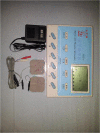P6 acupoint stimulation for prevention of postoperative nausea and vomiting in patients undergoing craniotomy: study protocol for a randomized controlled trial
- PMID: 23710881
- PMCID: PMC3668145
- DOI: 10.1186/1745-6215-14-153
P6 acupoint stimulation for prevention of postoperative nausea and vomiting in patients undergoing craniotomy: study protocol for a randomized controlled trial
Abstract
Background: The incidence of postoperative nausea and vomiting (PONV) is 50 to 79% after neurosurgery. Our study is designed to evaluate the efficacy of pericardium 6 (P6; also known as Neiguan) acupoint stimulation versus placebo, and versus routine antiemetic for the prevention of PONV after craniotomy, as well as to compare the efficacy of invasive acupuncture with non-invasive transcutaneous electrical nerve stimulation (TENS) on P6.
Methods/design: This is a single-center, prospective, double-blind, five-arm, parallel-group, randomized controlled trial (RCT). All groups will be given routine intravenous ondansetron 8 mg administered before skin closure. Upon regaining consciousness from general anaesthesia, patients will receive one of five interventions: 1) P6 acupuncture bilaterally for 30 minutes, stimulated every 10 minutes to keep de qi sensation; 2) sham acupuncture bilaterally for 30 minutes with no stimulation; 3) P6 stimulation via active TENS electrodes bilaterally for 30 minutes, with stimulation frequency and intensity set to when de qi sensation is felt; 4) sham P6 stimulation via inactive TENS electrode bilaterally for 30 minutes; and 5) usual practice of pharmacological emesis prevention. The incidence of postoperative vomiting during the first 24 hours is the main outcome. Secondary outcomes include: complete response rate, severity of nausea, total rescue metoclopramide dose used and patient satisfaction with PONV management.
Discussion: The results from this study could potentially confirm that P6 acupoint stimulation is an effective adjunct to standard antiemetic drug therapy for the prevention of PONV in patients undergoing craniotomy. Our study may also confirm that conventional acupuncture is more effective than TENS.
Trial registration: This study is registered with the Chinese Clinical Trial Registry: ChiCTR-TRC-13003026.
Figures



References
-
- Gan TJ, Meyer T, Apfel CC, Chung F, Davis PJ, Eubanks S, Kovac A, Philip BK, Sessler DI, Temo J, Tramer MR, Watcha M. Consensus guidelines for managing postoperative nausea and vomiting. Anesth Analg. 2003;97:62–71. - PubMed
Publication types
MeSH terms
Substances
LinkOut - more resources
Full Text Sources
Other Literature Sources
Medical
Research Materials

